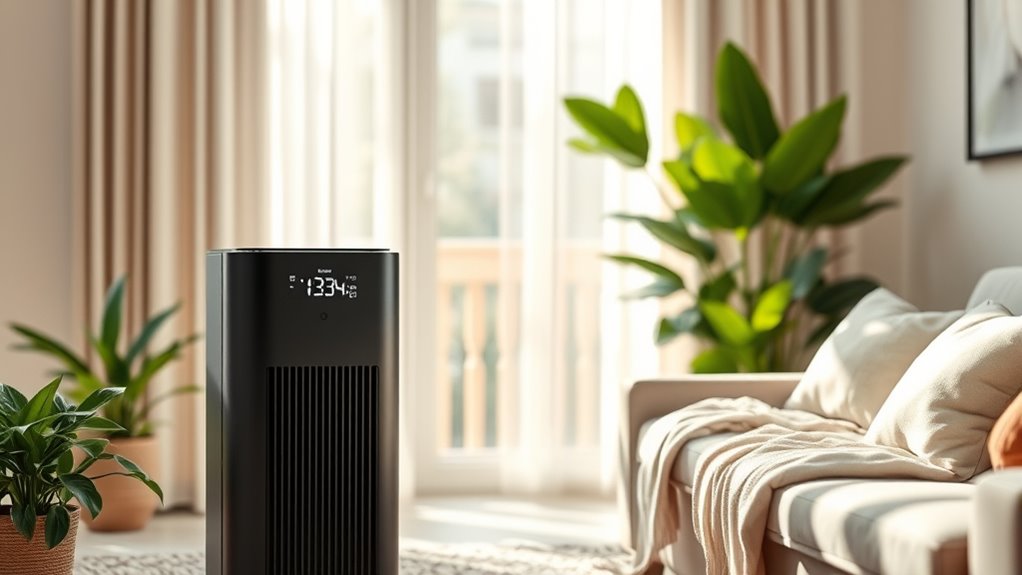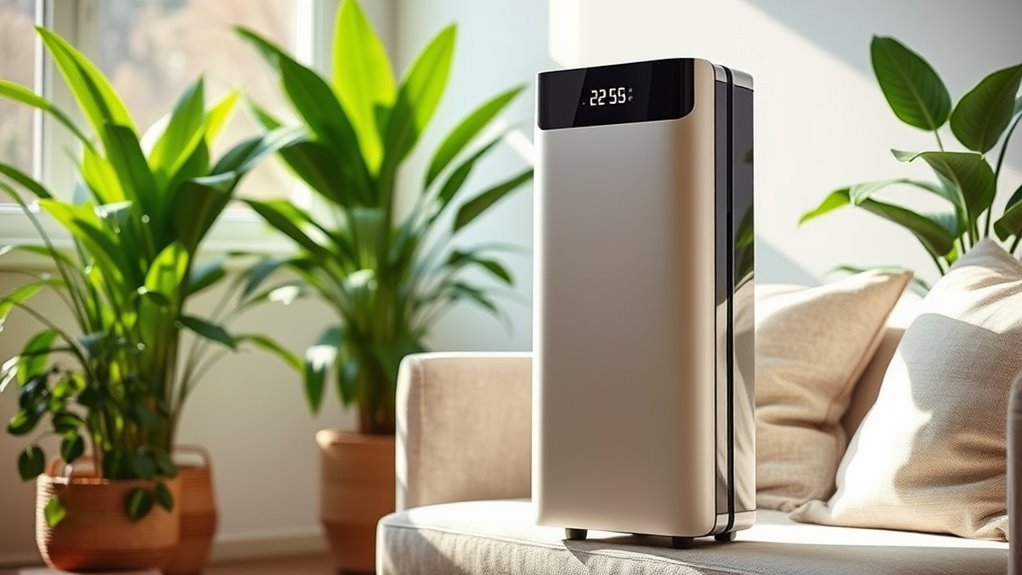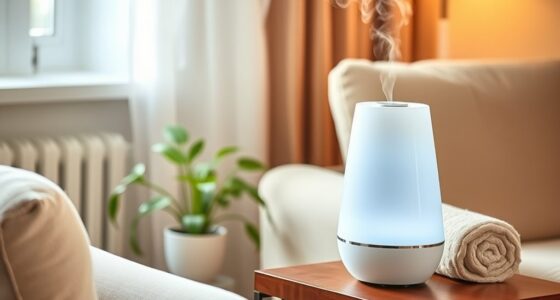Understanding air purifier CADR helps you choose the right device to improve your home’s air quality. CADR measures how fast and effectively the purifier filters dust, pollen, or smoke. Higher ratings mean quicker results. But ratings depend on factors like placement, room size, and filter condition. Don’t fall for myths—pay attention to real-world tips for best use. If you keep exploring, you’ll discover smarter ways to create a healthier indoor environment.
Key Takeaways
- CADR measures how quickly an air purifier can clean specific pollutants like dust, pollen, or smoke.
- Higher CADR ratings indicate more efficient and faster removal of airborne contaminants.
- Proper maintenance and placement are essential to ensure the purifier performs at its rated capacity.
- Continuous operation and sensor use help maintain optimal indoor air quality.
- Matching CADR to room size and pollutant levels ensures effective and healthy home air purification.
Understanding the Basics of Air Purifier Performance

To understand how an air purifier performs, you need to know the key factors that determine its effectiveness. One critical aspect is how well it improves air quality. The stronger the purifier, the more pollutants, allergens, and odors it can remove from your space. Another essential factor is filter lifespan, which directly impacts its ability to maintain high air quality over time. A longer-lasting filter ensures consistent performance and reduces the frequency of replacements, saving you money and effort. Keep in mind that filters become less effective as they accumulate dirt and particles. Regularly checking and replacing filters when needed helps maintain ideal air quality. Understanding these basics allows you to choose an air purifier that truly meets your needs for a healthier living environment.
Decoding the Meaning of CADR and Its Importance

Understanding how well an air purifier performs involves more than just looking at its features; it also requires understanding specific measurements like CADR. CADR, or Clean Air Delivery Rate, shows how effectively an air purifier can improve air quality by removing pollutants from the air. It measures the volume of filtered air delivered per minute, helping you compare units for different pollutant sources like dust, smoke, or pollen. A higher CADR means faster and better removal of airborne contaminants, which is vital if your home faces frequent pollutant sources. Knowing this number allows you to select an air purifier that matches your space size and pollution level. Ultimately, understanding CADR helps guarantee cleaner air and a healthier indoor environment.
How to Interpret CADR Numbers for Different Pollutants

Understanding CADR ratings helps you select an air purifier that effectively targets specific pollutants. Different pollutants have distinct metrics, so knowing how to interpret these numbers guarantees you’re making the right choice. Comparing CADR values across pollutants lets you prioritize what matters most for your indoor air quality.
Understanding CADR Ratings
CADR ratings provide a straightforward way to compare air purifiers based on how effectively they remove specific pollutants. When interpreting these numbers, consider the HEPA efficiency, which indicates how well the purifier captures tiny particles like dust and allergens. Higher CADR scores mean faster removal, making it easier to clean the air in larger spaces. Keep noise levels in mind too; some purifiers with high CADR ratings can be louder, which may affect your comfort. While a high CADR shows strong performance, it doesn’t tell you everything about specific pollutants or long-term efficiency. Use CADR ratings as a quick benchmark, but also consider your room size, noise preferences, and the purifier’s HEPA efficiency for a balanced choice.
Pollutant-Specific Metrics
When evaluating CADR ratings, it’s important to recognize that different pollutants require different levels of filtration. The CADR numbers are often specific to particles like dust, pollen, or smoke, reflecting how well your air purifier detects and removes each type. To interpret these metrics effectively:
- Check the pollutant-specific CADR for the targeted pollutant, ensuring it matches your air quality needs.
- Understand that higher CADR values indicate faster removal, especially vital for pollutants like smoke or VOCs.
- Recognize that pollutant detection varies; some purifiers excel at filtering certain particles but may be less effective with others.
- Use these metrics to select a device that offers balanced performance tailored to your home environment and pollutant profile.
Accurate pollutant detection and appropriate CADR ratings help you achieve ideal indoor air quality efficiently.
Comparing Different Pollutants
Because different pollutants vary in size and composition, the CADR numbers for dust, pollen, and smoke can differ considerably, making it crucial to interpret these ratings carefully. Higher CADR values mean the purifier removes specific pollutants more effectively, which improves overall air quality. For example, a high CADR for smoke indicates strong removal of fine particles, essential for reducing indoor air pollution caused by cigarette smoke or cooking fumes. Conversely, a high pollen CADR is indispensable during allergy seasons. Understanding these differences helps you select a purifier tailored to your pollutant types. Keep in mind that some purifiers excel at removing certain pollutants but may be less effective against others. Comparing CADR ratings across pollutant categories ensures you choose the best device for your specific air quality needs.
Factors That Affect an Air Purifier’s Effectiveness

Several factors can influence how well an air purifier performs in your space, and understanding these can help you choose the right model. First, airflow efficiency matters because it determines how quickly and effectively air circulates through the unit. Second, the filter lifespan impacts long-term performance; a filter that needs frequent replacing may reduce overall efficiency. Third, room size plays a role—using a purifier designed for smaller spaces in a large room limits its effectiveness. Fourth, placement is key; placing the device in a spot with good airflow maximizes its ability to clean the air. Being mindful of these factors ensures your air purifier works *effectively*, providing cleaner air and better wellness benefits over time.
Practical Tips for Choosing the Right Air Purifier for Your Home

Choosing the right air purifier for your home begins with understanding your specific needs and the space you want to improve. Consider room size, air quality concerns, and your budget. For ideal air purifier installation, place it where airflow isn’t blocked and away from walls or furniture. Regular maintenance tips include changing filters as recommended and cleaning the exterior to guarantee efficiency. Use the table below to compare features:
| Feature | Importance |
|---|---|
| Room Size Compatibility | Ensures effective purification without overworking the unit |
| Filter Type | HEPA for allergens; activated carbon for odors |
| Noise Level | Choose quieter models for bedrooms or workspaces |
Matching these factors helps you select an effective, low-maintenance unit tailored to your home.
Common Myths and Misconceptions About Air Purifier Ratings

Many consumers believe that higher-rated air purifiers automatically provide better performance, but this isn’t always true. This is a common myth busting mistake rooted in rating misconceptions. A higher CADR or ACH number doesn’t guarantee superior filtration for your specific needs. Instead, consider factors like room size and filter type.
Here are key points to keep in mind:
- Ratings reflect specific test conditions, not real-world performance.
- A high rating on one model doesn’t mean it’s better than a lower-rated one for your space.
- Filter quality and maintenance impact effectiveness more than just the rating.
- Always match an air purifier’s rating to your room size and air quality needs.
Understanding rating misconceptions helps you make smarter choices for home comfort.
Maximizing Indoor Air Quality With Optimal Air Purifier Use

To maximize indoor air quality with your air purifier, you need to use it correctly and consistently. Start by monitoring your air quality sensors; they provide real-time data on pollutants and help you adjust settings accordingly. Keep your filters in top shape through regular filter maintenance, replacing or cleaning them as recommended by the manufacturer. This guarantees ideal filtration efficiency and prevents the buildup of trapped particles that could re-enter your indoor air. Position your purifier in high-traffic or pollutant-prone areas for maximum impact. Additionally, run your purifier continuously or during peak pollution times to maintain consistent air quality. Combining proper operation with regular filter maintenance and sensor monitoring will markedly improve your indoor environment.
Frequently Asked Questions
How Often Should I Replace My Air Purifier’s Filters?
You should replace your air purifier’s filters every 6 to 12 months, depending on the filter lifespan and usage. Check the manufacturer’s recommendations for your specific model, as some filters need more frequent replacements, especially if you have pets or high pollution levels. Regularly inspecting and changing filters guarantees peak performance and air quality. Don’t wait too long—delayed replacements can reduce efficiency and compromise your home’s air cleanliness.
Do Air Purifiers Remove All Types of Indoor Allergens?
Think of your air purifier as a gatekeeper, but it doesn’t guard against every foe. HEPA filters excel at allergen removal, capturing pollen, pet dander, and dust mites effectively. However, they don’t remove every indoor allergen, like gases or volatile organic compounds. To truly shield your home, combine HEPA filters with activated carbon filters, creating a fortress that tackles a wide range of indoor allergens and improves your air quality.
Can Air Purifiers Help With Odors and Chemical Fumes?
Yes, air purifiers can help with odors and chemical fumes by providing odor elimination and chemical filtration. They trap airborne particles that cause bad smells and filter out VOCs (volatile organic compounds) from household chemicals. To get the best results, choose a purifier with activated carbon filters, which are especially effective at neutralizing odors and chemical fumes, improving your home’s air quality and making your space more comfortable.
What Maintenance Is Required to Keep an Air Purifier Effective?
To keep your air purifier effective, you should regularly check the filter lifespan and replace filters as recommended by the manufacturer. Clean the exterior and pre-filters weekly to prevent dust buildup. You might need to change HEPA or carbon filters every 6 to 12 months, depending on usage and air quality. Consistent cleaning and timely filter replacements guarantee your air purifier continues to enhance indoor air quality effectively.
Are There Noise Level Concerns With High-Performance Air Purifiers?
Think of noise levels as the whisper of a library versus a lawnmower. High-performance air purifiers can produce higher decibel ratings, which may be noticeable or disruptive, especially in quiet spaces. If you’re sensitive to noise, check the decibel ratings before buying. Many models now feature quieter modes, so you can enjoy clean air without sacrificing peace and quiet. Keep noise concerns in mind for a truly comfortable environment.
Conclusion
Understanding CADR helps you pick the right air purifier for your space, ensuring cleaner, healthier air. Did you know that a high CADR can filter out up to 99% of airborne pollutants? By considering factors like room size and pollutant type, you can maximize your indoor air quality. With the right knowledge, you’ll breathe easier and enjoy a more comfortable home—because better air truly makes a difference.









